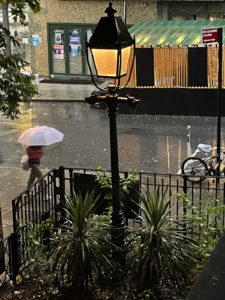Dee Evetts
Homelessness is a topic that I have sidestepped in these pages for almost two years. This was due in part to some lingering doubts about the subject as a source or inspiration for haiku. Not on my own account, so much as given pause by opinions often strongly expressed.
At its most simplistic, the ethical or moral objection is to making art out of other people’s misfortune, thus perceived as a form of exploitation. My considered view is that the thinking behind such statements is both naive and confused. I would argue as follows. It is axiomatic that no subject under the sun is inappropriate to haiku, in particular, and to literature in general neither vagrancy nor prostitution, not impotence, senility, or physical disablement. All are part of life’s pageant, or in less purple language, what we completely and collectively are.
What matters is not the subject, but the writer’s attitude. Is the reader invited to ridicule, to condescend, bolster a sense of safety and normality? Or, on the contrary, is there a spirit of enquiry, of empathy, and true compassion founded on the underlying knowledge: there but for the grace of God go I? (Or mores simply yet: there go I.)
I must be brief, or there will be no room left for examples. Yet in passing I want to mention a far more incisive critique, offered by John Stevenson. In a recent conversation he speculated, “Could homelessness become the cherry blossoms of our time?” Now there s a disquieting question which I shall leave hanging.
For reasons of space, I am ignoring work based on firsthand experience (Santōka, Tom Tico…) in order to focus on homelessness observed. Our first observer is Pamela Miller Ness:
daybreak
shifting his sack of cans
shoulder to shoulder (1)
This poem stands out from the many I have received, for several reasons. There is no message or idea being paraded here. What we get is pure observation, acute and specific enough to make us feel the subject’s aches and pains, and thereby to enter however briefly into his life predicament. The piece is all the more effective for its avoidance of the term homeless, which being generic often hinders my perception of an individual as real as myself. (It is this formulaic aspect that troubles John Stevenson, I would guess.)
The four poems below exhibit a more standard approach to the subject. These are by Barry George, Michael Ketchek, John Dunphy and Donald McLeod, respectively:
After the storm
he is rich in umbrellas
the homeless man (2)
windy day
stars and stripes waving
from homeless man’s cart (3)
flophouse
beneath the ex-boxer’s pillow
his scrapbook (4)
heart of the city –
a row of winos watching
the building excavation (5)
In each case the poet has taken a position that might fairly easily be paraphrased (readers may wish to try this). This is not to say that such a paraphrasing could replace the poems, for each has a life and validity of its own. These pieces succeed admirably on their own terms.
Tom Painting here offers us something to be pondered longer, perhaps:
photo exhibit
faces of the homeless
in black and white (6)
This eludes any attempt at summary. By pointing to a cliché of photojournalism, the poet may be suggesting how difficult it is for most of us not to view homelessness through a lens consisting of our own prejudices and idealizations.
An unusual angle is to be found in Ed Baker’s
mowing the grass
worrying
the homeless (7)
Here there is interaction as well as observation. A feeling of tension arises from the potential conflict of interests a collision of worlds usually held apart. The poem is not devoid of humor, which also works in its favor.
The same can be said of this comically forlorn picture evoked by David Cobb:
cathedral front
a drop-out sits with angels
made of stone (8)
He has conjured up uncannily my own memories of sleeping rough in Europe, after abandoning university. This was not real homelessness, to be sure. Yet a sufficient taste of it to glimpse how even vagrancy contains a lure that could become compelling. And this is the aspect that most unsettles us, I suspect, undermining as it does the sense of substance and identity conferred by our houses and apartments.
A suitable envoie is provided by Charlotte DiGregorio, with this very quiet poem:
fog blankets
the downtown bridge…
homeless man vanishes (9)
As easily and anonymously as this the homeless slip from sight, and from our thoughts.
—————–
1. unpublished; 2. Point Judith Light, Spring-Summer 1999; 3. RAW NerVZ V:2; 4. unpublished; 5. unpublished; 6. unpublished; 7. unpublished; 8. unpublished; 9. unpublished.
